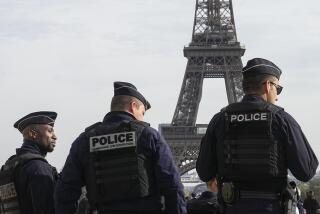Police Will Mount Up to Fight Increased Crime in Downtown Business Area
Fears that the revitalization of downtown’s central business district is being threatened by increasing crime prompted the city’s Community Redevelopment Agency on Wednesday to finance a pilot program to put mounted police patrols on the streets.
“There’s a tremendous amount of crime in the downtown area and this particular pilot program is being initiated to fight that,” said CRA treasurer Irene Ayala in endorsing the three-month Los Angeles Police Department program. “There’s a notion that people on horseback are more of a presence than patrolmen on foot.”
Under the plan, members of the department’s 50-member mounted unit will patrol an area bounded roughly by Spring Street and Broadway between 2nd and 9th streets looking for illegal drug activity and other crimes that have become a growing concern to merchants in the area and private investors.
Echoing their fears in a letter to the Police Commission last summer, Mayor Tom Bradley said redevelopment of the area was being threatened by what he called the “unhealthy environment.”
To date, the city has pumped $70 million into the 13 1/2-block central downtown area and private investors and the state have committed $870 million more for a variety of office, residential, cultural and parking facilities.
“These fragile beginnings of private investment interest are . . . threatened by a recent explosion of street crime,” Bradley wrote in asking for the police to come up with an anti-crime plan. The situation, the mayor said, “is jeopardizing our ability to bring to fruition . . . redevelopment, rehabilitation and reoccupancy of Spring Street and the preservation of the retail vitality of Broadway.”
Lobbying hard in recent months for more police patrols, area merchants have complained that drug dealers are openly peddling their wares on the streets. Robberies, purse snatchings and other crimes are on the upswing.
“I have seen people openly passing the pills on the sidewalks,” said James DeBie, the vice president and manager of the Security Pacific Bank branch at 6th and Spring streets. “Our customers have had their purses snatched. A lot of them are afraid to come into the area.
“It gets to the point where we face a choice of do we want to stay here or not. Other businesses are going to feel the same way. . . .”
“You see the sale of cocaine and drugs, of what appear to be stolen goods,” added Leonard Glickman, the president of a coalition of property owners and merchants known as the Spring Street Assn.
“We’ve gotten an influx of drug dealers, prostitution, unsavory characters . . . the kind of people who make others afraid to walk past.”
Capt. Rick Batson of the LAPD’s Central Division confirms that crime along streets throughout the central business district is indeed “statistically up.”
Police made 1,448 arrests during the first six months of 1986, compared to 1,179 during the same period last year, Batson reported. The greatest increases were for robbery and narcotics offenses.
“It’s out of control in terms of narcotics activity,” Batson said. “It’s flagrant, it’s obvious and it’s almost unenforceable. We arrest one and then two take their place before we can get them to the station. . . . But that’s citywide.
“With this proposal, we’re trying to find different alternatives to make the people feel safer and actually reduce crime.”
The aim of the horseback patrols, Batson and others say, is to make police more obvious. Used recently to patrol the crowds at the Los Angeles Street Scene and last summer in Westwood, the mounted officers are “more visible and very mobile,” said Lt. Dave Aikins, the officer in charge of the unit.
“The visibility is good for the officer and for people who need the police,” Aikin said. “And in a situation where there is a lot of pedestrian traffic, they move in and out of places fast.”
Initially, the mounted officers will be used to augment foot patrols during daytime hours. The trial program, which will cost $70,000, is expected to begin within several weeks.
More to Read
Sign up for Essential California
The most important California stories and recommendations in your inbox every morning.
You may occasionally receive promotional content from the Los Angeles Times.










